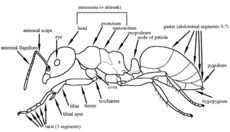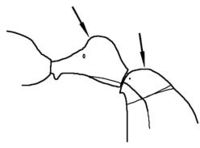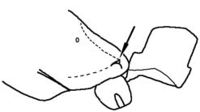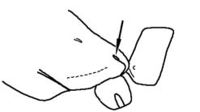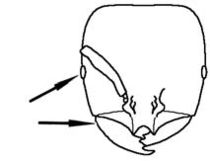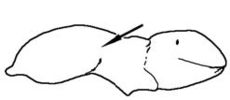Key to the subfamilies of the southwestern Australian Botanical Province
This key to workers is based on: Heterick, B. E. 2009a. A guide to the ants of South-western Australia. Records of the Western Australian Museum, Supplement 76: 1-206. Part 1.
You may also be interested in
1
- Dorsum of pygidium flattened, margins of flattened area armed laterally, posteriorly, or both, with a series of denticles or short spines (Figure 5); abdominal segments V–VII with spiracles visible in intact specimen; promesonotal suture usually completely absent (absent in all known Australian species) . . . . . Dorylinae - this subfamily has been revised since 2009. There are now three genera in this subfamily known from the SWBP. Ooceraea has one species present, Ooceraea australis. It has no eyes and its antennae are 9-segmented. The other two genera have species that may or may not have eyes but all have more than 9 antennal segments. Lioponera can be distinguished from Zasphinctus by the presence of a dorsolateral margin along the length of the petiole: Key to SWBP Lioponera. In Zasphinctus there is no dorsolateral margin and the face between the dorsal and lateral portions of the petiole are rounded: Key to SWBP Zasphinctus.
- Dorsum of pygidium without series of denticles or short spines; abdominal segments V–VII with spiracles visible only when abdomen is distended or dissected (except for Aenictinae) (e.g. Figures 6, 7); promesonotal suture present or absent . . . . . 2
2
return to couplet #1
- Waist consisting of a single distinct segment (the petiole); abdomen may be more-or-less deeply impressed behind segment III (Figures 2, 7) . . . . . 3
- Waist consisting of two distinct segments (the petiole and postpetiole), segment III being distinctly separate from remaining abdominal segments, which are smoothly rounded (Figure 3) . . . . . 10
3
return to couplet #2
- Apex of hypopygium with a circular or semicircular cone (the acidipore), usually projecting as a nozzle and modified to spray formic acid and often fringed with hairs (Figures 8, 9) . . . . . Formicinae
- Apex of hypopygium without an acidipore . . . . . 4
4
return to couplet #3
- Apex of abdomen (junction of hypopygium and pygidium) with a transverse slit (Figures 10, 11); abdomen without an impression between the third and fourth abdominal segments, often soft, flexible and easily collapsed; mandibles triangular with teeth along entire inner margin . . . . . Dolichoderinae
- Apex of abdomen with a sting; abdomen may be deeply impressed between third and fourth abdominal Segments (Figure 7); cuticle stronger, less flexible, not normally collapsible; mandibular shape various . . . . . 5
5
return to couplet #4
- Petiole broadly articulated to abdominal segment III (Figure 12); dentiform (i.e. toothlike) clypeal setae present (Figure 13) (one genus, Amblyopone) . . . . . Amblyoponinae - the ants in this subfamily in the SWBP belong to two genera, Amblyopone and Onychomyrmex. They are both included in the now modified key to SWBP Amblyopone
- Petiole with distinctly descending posterior face; dentiform clypeal setae absent . . . . . 6
6
return to couplet #5
- Petiole approximately as long as to slightly longer than abdominal tergite III (Figure 14); mandibles elongate-triangular, intermeshing (15 or more small teeth present) (Figure 15) . . . . . Myrmeciinae (in part - also #10)
- Without the above combination of characters . . . . . 7
7
return to couplet #6
- In profile, metapleural gland orifice a longitudinal to oblique curved slit or crescent, directed upward by a strip of cuticle (Figure 16) (one genus, Rhytidoponera) . . . . . Ectatomminae
- In profile, metapleural gland orifice elliptical to circular and opening laterally or posteriorly, not bounded by strip of cuticle that directs orifice upward (Figure 17) . . . . . 8
8
return to couplet #7
- Promesonotal suture either completely absent or present and reduced and fully fused, so pronotum and mesonotum are incapable of independent movement (Figure 18); antennal sockets mostly to completely exposed (Figure 19) (one genus, Discothyrea) . . . . . Proceratiinae - one genus present: Discothyrea
- Promesonotal suture fully developed, so pronotum and mesonotum capable of independent movement (Figure 20); antennal sockets covered by developed frontal lobes (Figure 21) . . . . . 9
9
return to couplet #8
- Torulus of antenna completely fused to frontal lobe; frontal lobes are rounded or triangular, and in full-face view have a decidedly ‘pinched in’ appearance posteriorly (Figure 21); anterior clypeal margin without lamellate rim; in full-face view, head capsule without median longitudinal carina (Figure 22) . . . . . Ponerinae
- Torulus of antenna not completely fused to frontal lobe; frontal lobes not rounded or triangular in appearance, and not ‘pinched in’ posteriorly, anterior clypeal margin with lamellate rim; in full-face view, head capsule with median longitudinal carina (one genus, Heteroponera) . . . . . Heteroponerinae - one genus present: Heteroponera
10
return to couplet #2
- Mandibles long and more or less linear, usually with teeth along entire inner margin; eyes very large, situated on or near the anterior margin of the clypeus (Figure 23) . . . . . Myrmeciinae (in part - also #6)
- Mandibles usually triangular, but if elongate, then without teeth on inner margin (teeth at mandibular tip only), and eyes small or medium-sized, situated away from anterior margin of clypeus . . . . . 11
11
return to couplet #10
- Eyes normally present, but if absent then frontal lobes expanded so that the latter cover all or part of antennal insertions (Figure 24) . . . . . 12
- Eyes absent or represented by a single facet; frontal lobes absent, so that the antennal insertions are completely exposed (Figure 25) . . . . . 13
12
return to couplet #11
- Pronotum and mesonotum fused to form one segment (the promesonotum) (Figure 26); hind tibiae with at most a simple spur, but this may be lacking; tarsal claws simple (Figure 27) . . . . . Myrmicinae
- Joint between pronotum and mesonotum flexible (Figure 28); hind tibiae with pectinate spurs; tarsal claws toothed (Figure 29) (one genus, Tetraponera) . . . . . Pseudomyrmecinae - There is a single species of this subfamily present in the SWBP: Tetraponera punctulata
13
return to couplet #11
- Pronotum and mesonotum fused to form one segment; antennae 10-segmented; length greater than 3 mm (Figure 30) (one genus, Aenictus) . . . . . Aenictinae (now Dorylinae)
- Joint between pronotum and mesonotum flexible (Figure 31); antennae 12-segmented; length less than 2.5 mm (one genus, Leptanilla) . . . . . Leptanillinae - There is a single species of this subfamily present in the SWBP: Leptanilla swani



